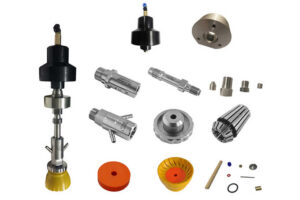Precision CNC Waterjet Cutting Manufacturer in China – Advanced Cutting Solutions
Introduction to Our CNC Waterjet Cutting Services
 As a leading CNC waterjet cutting manufacturer in China, we specialize in delivering high-precision cutting solutions for a wide range of materials and industries. Our state-of-the-art waterjet cutting technology combines ultra-high pressure water with abrasive garnet to cut through virtually any material with exceptional accuracy and minimal material waste.
As a leading CNC waterjet cutting manufacturer in China, we specialize in delivering high-precision cutting solutions for a wide range of materials and industries. Our state-of-the-art waterjet cutting technology combines ultra-high pressure water with abrasive garnet to cut through virtually any material with exceptional accuracy and minimal material waste.
With [X] years of experience in waterjet cutting, we serve global clients across aerospace, automotive, architecture, marine, and industrial manufacturing. Our China-based facility offers cost-effective waterjet cutting services without compromising on quality or precision.
Why Choose Waterjet Cutting?
Waterjet cutting provides unique advantages over traditional cutting methods:
✔ Cold Cutting Process – No heat-affected zones (HAZ)
✔ Material Versatility – Cuts metals, stone, glass, composites, and more
✔ Complex Geometries – Intricate shapes with tight tolerances
✔ No Tool Wear – Unlike laser or plasma cutting
✔ Environmentally Friendly – No hazardous fumes or waste
Materials We Cut:
| Material Type | Thickness Capacity | Common Applications |
|---|---|---|
| Stainless Steel | Up to 200mm | Aerospace components, medical devices |
| Aluminum | Up to 300mm | Automotive parts, heat sinks |
| Titanium | Up to 150mm | Aircraft frames, implants |
| Carbon Steel | Up to 250mm | Industrial machinery parts |
| Stone & Tile | Up to 100mm | Architectural features |
| Glass | Up to 50mm | Decorative panels, displays |
| Rubber & Foam | Up to 300mm | Gaskets, seals, insulation |
Our CNC Waterjet Cutting Capabilities
1. Advanced Cutting Technologies
We operate high-pressure CNC waterjet systems (up to 90,000 psi) with:
- 5-Axis Cutting Heads – For complex 3D bevel cuts
- Dynamic Waterjet XD Technology – For straighter edges on thick materials
- Abrasive Recycling Systems – To reduce operating costs
2. Precision Cutting Specifications
- Cutting Tolerance: ±0.1mm (standard), ±0.05mm (high precision)
- Kerf Width: 0.8-1.2mm (depending on material)
- Maximum Cutting Area: 4m × 2m (custom sizes available)
- Surface Finish: 125-250 Ra μm (as-cut)
3. Secondary Services
- Edge Polishing – For decorative finishes
- Deburring – Smoothing sharp edges
- Heat Treatment – Stress relief for precision parts
- Powder Coating/Painting – Protective finishes
Industries We Serve
1. Aerospace & Defense
- Titanium aircraft brackets
- Aluminum structural components
- Composite radome panels
2. Automotive Manufacturing
- Chassis components
- Gaskets and seals
- EV battery enclosures
3. Architecture & Design
- Decorative metal screens
- Stone countertops & wall cladding
- Artistic glass installations
4. Industrial Equipment
- Heavy machinery parts
- Conveyor system components
- Hydraulic valve bodies
5. Marine & Offshore
- Corrosion-resistant fittings
- Propeller components
- Shipbuilding plates
Quality Assurance Process
We maintain strict quality control:
- Material Certification – Verify material grade and properties
- Machine Calibration – Daily pressure and alignment checks
- First-Cut Inspection – Verify programming accuracy
- Dimensional Verification – CMM for critical parts
- Visual Inspection – Check for edge quality and defects
Our facility is ISO 9001:2015 certified, with capability for AS9100 aerospace standards.
Competitive Advantages
✅ China Manufacturing Benefits
- 40-60% cost savings vs. Western suppliers
- Short lead times (3-5 days for prototypes)
✅ Advanced Technology
- Latest OMAX and Flow waterjet systems
- 3D cutting capability for complex parts
✅ Material Efficiency
- Nesting software optimization reduces waste
- Abrasive recycling lowers operational costs
✅ Engineering Support
- DFM (Design for Manufacturing) advice
- Cutting strategy optimization
Waterjet Cutting vs. Other Methods
| Cutting Method | Advantages | Limitations |
|---|---|---|
| Waterjet | No heat distortion, cuts any material | Slower than laser for thin metals |
| Laser | Fast for thin metals | Heat-affected zones, reflective material limits |
| Plasma | Fast for thick metals | Poor edge quality, heat distortion |
| EDM | Extreme precision | Conductivity required, very slow |
Case Study: Aerospace Component Cutting
Project: Titanium Aircraft Brackets
Material: 6Al-4V Titanium, 25mm thick
Quantity: 500 pieces
Challenges:
- Tight tolerance (±0.1mm)
- No edge hardening permitted
Solution: - Specialized abrasive mix
- Slow cutting speed for precision
- 100% CMM inspection
Results: - Zero rejected parts
- 20% cost savings vs. previous supplier
Our Waterjet Cutting Process
- File Preparation – Convert CAD to cutting path
- Material Setup – Secure workpiece
- Cutting – High-pressure waterjet operation
- Post-Processing – Deburring if required
- Inspection – Verify dimensions
- Packaging – Protective wrapping
Why Choose China for Waterjet Cutting?
- Lower operational costs
- Skilled technicians
- High-capacity facilities
- Efficient global logistics
Get Started With Us
📩 Send Your CAD Files (DXF, DWG, STEP preferred)
💰 Receive Quote in 24 Hours
🛠️ Fast-Track Production Available
🔍 Inspection Reports Provided
🚢 Worldwide Shipping
Conclusion: Your Trusted Waterjet Partner
As a professional CNC waterjet cutting manufacturer in China, we deliver precision-cut components with exceptional edge quality and competitive pricing. Our advanced waterjet systems and experienced team ensure your parts meet the highest standards.
Contact us today to discuss your project requirements!






